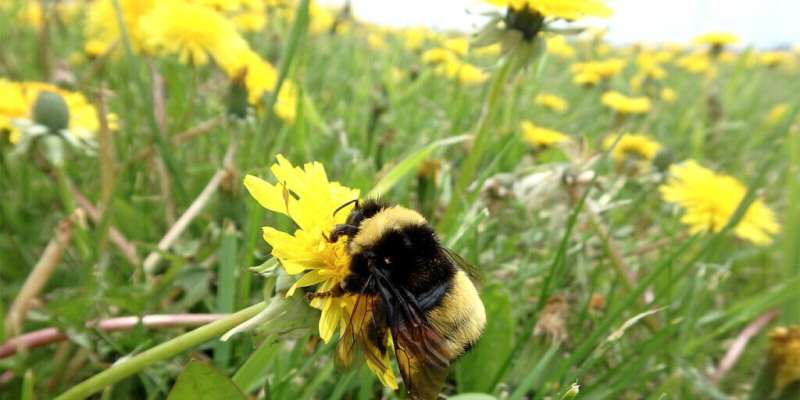This article has been reviewed according to Science X's editorial process and policies. Editors have highlighted the following attributes while ensuring the content's credibility:
fact-checked
trusted source
proofread
National pollinator strategy needed to save Canada's wild bees, say researchers

Canada's wild pollinators are in decline and without a national pollinator plan, many species could be heading for extinction, like the endangered rusty-patched bumblebee or the American bumblebee, say researchers at York University.
Although the focus is usually on managed honey bees, unlike wild pollinators, they are not native to Canada, not adapted to this country's weather or plants and not at-risk of extinction, says the researchers. Wild pollinators are essential to Canada's economy, food security and ecosystems, but about 30 species, including eight bee species, are listed under Canada's Species at Risk Act. In the United States alone, non-managed wild pollinators are estimated to provide more than US$3 billion worth in crop pollination.
Because of the urgency, and the multiple and widespread nature of the threats to wild pollinators, Associate Professor Sheila Colla of York's Native Pollinator Research Lab in the Faculty of Environmental and Urban Change and Postdoctoral Fellow Rachel Nalepa, tapped into the extensive knowledge of pollinator and conservation experts to develop solutions for wild pollinator conservation in Canada, along with a national pollinator framework with a clear set of actions.
"Swift action is needed to protect wild pollinators, which will also benefit the agricultural sector, the environment and build climate change resiliency," says Colla.
The study, "Toward a wild pollinator strategy for Canada: Expert recommended solution and policy levers," which involved a series of expert surveys, was published June 22 in the journal FACETS and is accompanied by their pollinator framework—Conserving Canada's Wild Pollinators: National Strategy Recommendations.
"We've seen many other countries develop and implement pollinator protection policies, including our neighbors to the south, the U.S., which have incorporated pollinator protection into their farm bill and that has a lot of resources to go into creating habitat and other kinds of protections for at-risk bees," says Colla. Belgium, Spain, Norway, the Netherlands, France, Mexico, Ireland, Colombia, and Nigeria, and at least 24 other countries, have all adopted national strategies, plans or initiatives.
The researchers' pollinator framework is a tool to create Canada-wide pollinator policy based on the best available science and expertise, while also highlighting important knowledge gaps, areas for future research. It is based on their study, which generated 83 expert recommended solutions to some of the main threats—habitat loss, pesticides, parasites, non-native species and disease. It also outlines which recommendations are most feasible and which could be implemented immediately.
"The federal government is needed to help standardize and coordinate some national efforts, to set targets and to monitor progress towards those targets and also to provide financial resources and other support to provinces," says Nalepa.
The goal is to preserve the diversity of Canada's about 850 wild bee species and other pollinators, to mitigate issues arising from climate change, such as changing precipitation patterns, drought and shifts to their normal ranges, as well as to ensure resources are available for them to thrive, and crops and wildflowers are pollinated.
The use of pesticides is a big threat and there is a need for better risk assessments, a reduction on their reliance for agriculture, but the study's experts also point to a lack of knowledge about how combinations of pesticides affect wild pollinators.
"In addition, experts wanted to see more financial supports and guidance for agricultural communities as they strive to reduce their pesticide use and also to help growers increase their market access to seeds that haven't been treated with pesticides," says Nalepa.
To improve habitat, the framework suggests the creation of corridors to connect habitats and ensure pollinators can move easily between them to forage, overwinter and breed. This could be done by having native plants along roads, train tracks and hydro lines. Habitat could also be created or improved at large industrial sites—landfills, aggregate operations and brownfield areas.
The experts also suggest better tracking, management and disease screening for managed pollinators to help prevent the spread of disease to wild bees or vice versa.
"Although there are some things in the framework that will benefit managed pollinators, really, it's focussed on conserving wild pollinator species," says Colla. "What we've seen in the scientific literature is that in many cases even when you have honey bees in the system, native bees are doing a lot of the work, or they are more effective and more efficient at pollination."
In addition, there are some crops that require buzz pollination, where bumble bees create vibrations to dislodge trapped pollen. "Our wild bees and our native plant species have co-evolved over thousands and thousands of years, and we don't quite know what will happen to these plants when or if bee species or a handful of them go extinct," she says.
The take home message, says Nalepa, is that "the Canadian public is really passionate about wild pollinators, and even though experts stress the need for sustained efforts and systemic changes, there are also actions that we can take that are immediately implementable with just minor tweaks to the programing and legislation that we already have."
Even without a coordinated, national plan, there are things people can do now, such as minimizing garden clean-up because pollinators often live under leaves, thatched grass and in hollow plant stems, and participating in community science programs like BumbleBeeWatch.
Another recent study by Colla and a different team published in Urban Ecosystems looked at how managed honey bee hives in Toronto negatively impacted some wild bee species.
More information: Rachel Nalepa et al, Toward a wild pollinator strategy for Canada: expert-recommended solutions and policy levers, FACETS (2023). DOI: 10.1139/facets-2022-0204
Sarah MacKell et al, Assessing the impacts of urban beehives on wild bees using individual, community, and population-level metrics, Urban Ecosystems (2023). DOI: 10.1007/s11252-023-01374-4
Provided by York University




















